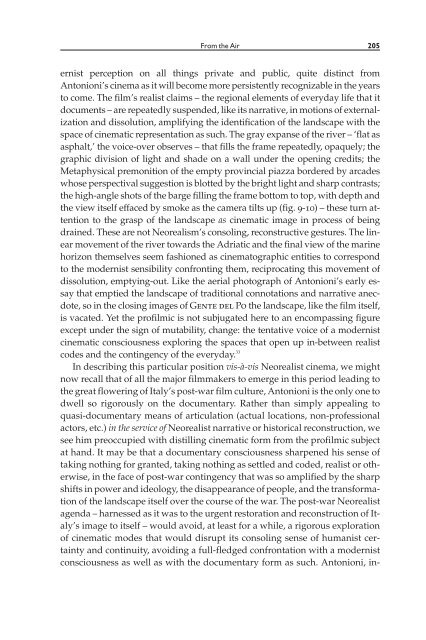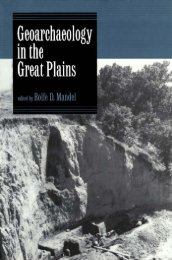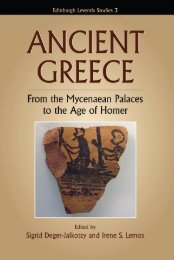Camera Obscura, Camera Lucida
Camera Obscura, Camera Lucida
Camera Obscura, Camera Lucida
You also want an ePaper? Increase the reach of your titles
YUMPU automatically turns print PDFs into web optimized ePapers that Google loves.
From the Air 205<br />
ernist perception on all things private and public, quite distinct from<br />
Antonioni’s cinema as it will become more persistently recognizable in the years<br />
to come. The film’s realist claims – the regional elements of everyday life that it<br />
documents – are repeatedly suspended, like its narrative, in motions of externalization<br />
and dissolution, amplifying the identification of the landscape with the<br />
space of cinematic representation as such. The gray expanse of the river – ‘flat as<br />
asphalt,’ the voice-over observes – that fills the frame repeatedly, opaquely; the<br />
graphic division of light and shade on a wall under the opening credits; the<br />
Metaphysical premonition of the empty provincial piazza bordered by arcades<br />
whose perspectival suggestion is blotted by the bright light and sharp contrasts;<br />
the high-angle shots of the barge filling the frame bottom to top, with depth and<br />
the view itself effaced by smoke as the camera tilts up (fig. 9-10) – these turn attention<br />
to the grasp of the landscape as cinematic image in process of being<br />
drained. These are not Neorealism’s consoling, reconstructive gestures. The linear<br />
movement of the river towards the Adriatic and the final view of the marine<br />
horizon themselves seem fashioned as cinematographic entities to correspond<br />
to the modernist sensibility confronting them, reciprocating this movement of<br />
dissolution, emptying-out. Like the aerial photograph of Antonioni’s early essay<br />
that emptied the landscape of traditional connotations and narrative anecdote,<br />
so in the closing images of Gente del Po the landscape, like the film itself,<br />
is vacated. Yet the profilmic is not subjugated here to an encompassing figure<br />
except under the sign of mutability, change: the tentative voice of a modernist<br />
cinematic consciousness exploring the spaces that open up in-between realist<br />
codes and the contingency of the everyday. 33<br />
In describing this particular position vis-à-vis Neorealist cinema, we might<br />
now recall that of all the major filmmakers to emerge in this period leading to<br />
the great flowering of Italy’s post-war film culture, Antonioni is the only one to<br />
dwell so rigorously on the documentary. Rather than simply appealing to<br />
quasi-documentary means of articulation (actual locations, non-professional<br />
actors, etc.) in the service of Neorealist narrative or historical reconstruction, we<br />
see him preoccupied with distilling cinematic form from the profilmic subject<br />
at hand. It may be that a documentary consciousness sharpened his sense of<br />
taking nothing for granted, taking nothing as settled and coded, realist or otherwise,<br />
in the face of post-war contingency that was so amplified by the sharp<br />
shifts in power and ideology, the disappearance of people, and the transformation<br />
of the landscape itself over the course of the war. The post-war Neorealist<br />
agenda – harnessed as it was to the urgent restoration and reconstruction of Italy’s<br />
image to itself – would avoid, at least for a while, a rigorous exploration<br />
of cinematic modes that would disrupt its consoling sense of humanist certainty<br />
and continuity, avoiding a full-fledged confrontation with a modernist<br />
consciousness as well as with the documentary form as such. Antonioni, in-






